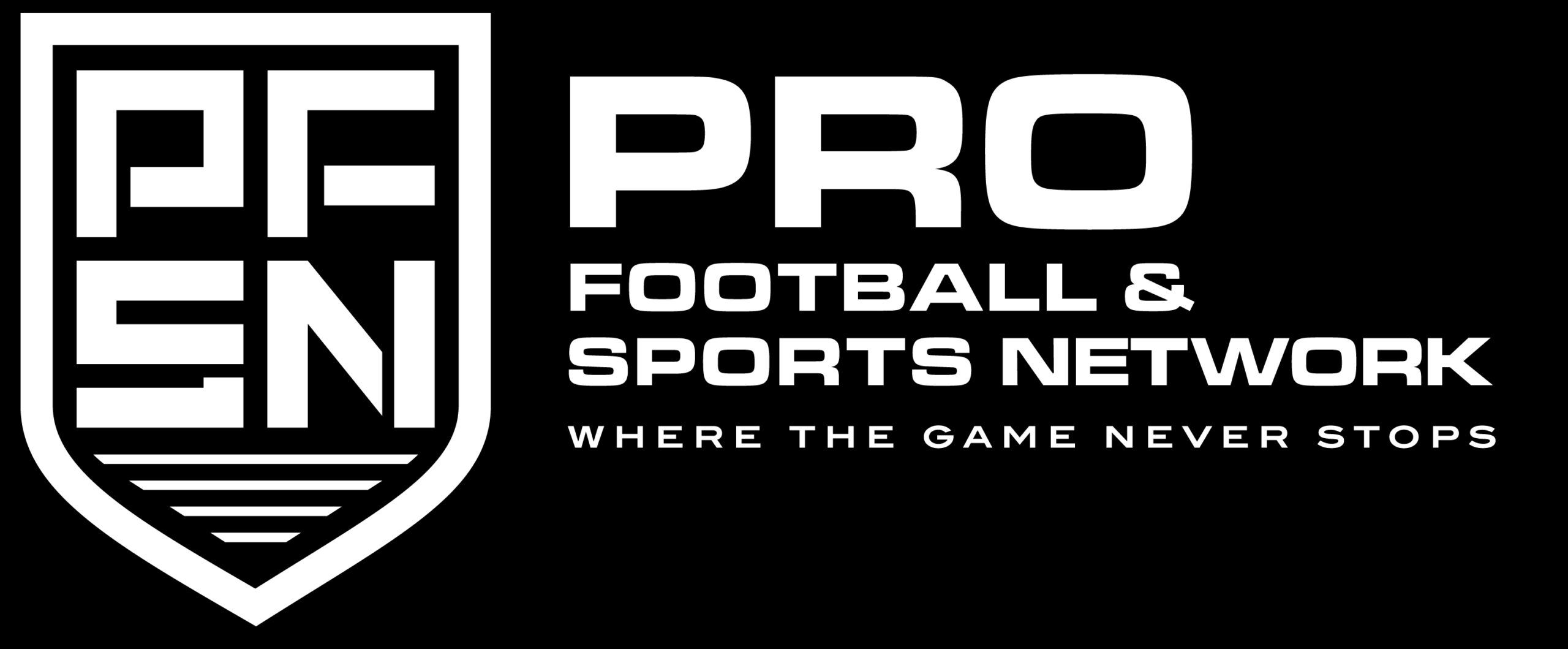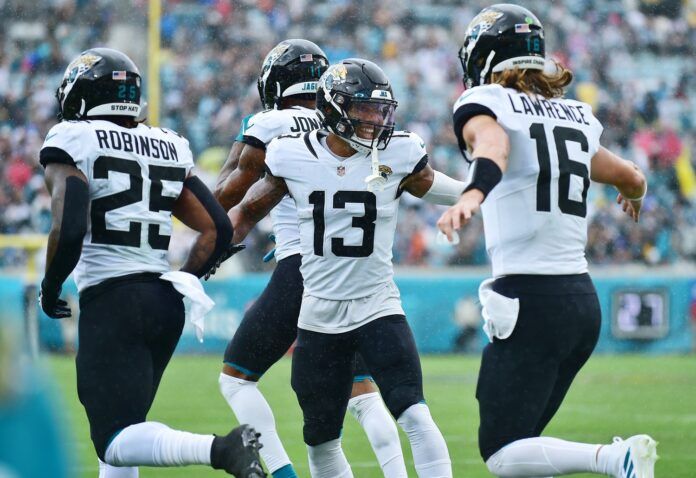Not every NFL position group is created equal. Some teams invest more on specific units than others, and that outlay is typically rewarded with improved performance — but that’s not always the case. Other clubs might overlook a certain position group, only to have a young player or an unheralded rookie unexpectedly shine. With one sixth of the 2022 season in the books, which units are overachieving and which are underachieving?
The NFL’s most overachieving and underachieving position groups
It’s only been three weeks, so the sample size of performance we’ve seen so far is inherently small. Still, we can get an idea of which units are performing up to expectations and which are struggling.
Overachieving | Jacksonville Jaguars pass catchers
After consecutive dominant victories over the Indianapolis Colts and Los Angeles Chargers, the Jaguars are the toast of the NFL world. Trevor Lawrence looks rejuvenated. Jacksonville has scored 28 points per game, good for eighth in the league. They’ve scored on 48.5% of their drives (first in the NFL) and have only committed a turnover on 3% (also first).
Everything is going swimmingly for the Jaguars, and there’s a lot of credit to go around. Head coach Doug Pederson represents a massive upgrade over Urban Meyer, Jacksonville’s offensive line is playing better than expected, and we haven’t even mentioned the defense.
But the Jags’ wide receivers have made the most waves through three weeks. Free agent addition Christian Kirk ranks eighth in the league with 267 yards. Fellow signee Zay Jones, the team’s second-leading receiver, got in on the action with 10 receptions, 85 yards, and a score in Week 3.
Marvin Jones Jr., one of the few pass-catching holdovers in Jacksonville, has 11 catches. Evan Engram caught seven balls in Week 2, then scored a touchdown in Week 3. Even Jamal Agnew showed some juice converting a 2nd-and-15 against Los Angeles.
Although Kirk is the focal point of the Jaguars’ passing attack, Lawrence is spreading the ball around. Kirk leads the club with a 25.5% target share, but that figure is only 20th among wide receivers league-wide. Give credit to Jacksonville’s front office and coaching staff for acquiring and deploying a diverse, productive set of pass-catching talent.
Underachieving | New York Giants wide receivers
The Jaguars spent cash to improve their receiving corps over the offseason, but the Giants already had a lot of pass-catching money on the books. New York is devoting the NFL’s second-most cap space to wide receivers, but their receptions leader through three games is journeyman Richie James, who is earning the league minimum.
The main culprit for the Giants is veteran Kenny Golladay, who is just two years into a four-year, $72 million contract. Buried on the depth chart, Golladay has only five targets and two receptions, both of which came in New York’s season opener. After complaining about his playing time, Golladay saw 24 snaps against the Cowboys in Week 3, but he was unable to find separation on routes and committed an unforgivable drop.
Injuries have affected Big Blue’s receiving corps, and we won’t hold Sterling Shepard or second-round rookie Wan’Dale Robinson’s health issues against them. But 2021 first-round pick Kadarius Toney, who has two receptions and two rushing attempts on the year, didn’t look like part of New York’s plans even before a hamstring injury flared up. And Darius Slayton (700+ yards in each of his first two seasons) has apparently been exiled to Elba.
The Giants’ first-year regime didn’t sign Golladay and didn’t draft Toney, so there’s no telling if they’ll change their approach regarding playing time. But it’s apparent that New York isn’t getting its money’s worth from its wide receiver expenditures.
Overachieving | Atlanta Falcons offensive line
The Falcons started the year 1-2, but they’ve been competitive in all three of their games. Head coach and offensive play-caller Arthur Smith is diversifying his personnel and mixing up his formations. Marcus Mariota is doing what’s asked of him, Cordarrelle Patterson is third in the NFL in rushing, and first-round rookie Drake London already looks like a WR1.
But the unit that’s truly impressed me in Atlanta is the offensive line. For years, the Falcons ran out one of the league’s worst front fives. They ranked in the top half of the NFL in pressure rate allowed in each of Matt Ryan’s final three seasons with the club, including a third-worst 28% in 2021.
This year, the Falcons are only giving up pressure on 16% of Mariota’s dropbacks, good for seventh-best in the league, and the team ranks fifth in pass-block win rate. In the run game, Atlanta’s backs are averaging 3.2 yards per carry before contact, the fourth-best rate in football.
Smith’s scheme and Mariota’s mobility certainly make it easier on the Falcons’ front five, but there’s also been clear development and better cohesion than in seasons past. Left guard Elijah Wilkinson (who won’t play in Week 4 due to injury) has represented a significant improvement over 2021 starter Jalen Mayfield, while right guard Chris Lindstrom remains among the best at his position.
Underachieving | Indianapolis Colts offensive line
Oh, how the mighty have fallen. The Colts offensive line, routinely viewed as one of the top units in the league, has actively hindered Indy’s performance through three games.
Ryan was supposed to be playing in front of the best line he’d ever worked with, but the results have been disastrous. He’s taken 12 sacks and been pressured on 28% of his dropbacks, and the Colts rank 30th in pass-block win rate.
Things haven’t been quite as egregious in the run game, but Jonathan Taylor hasn’t had any room to work with. A year after leading the league in rushing, Taylor’s yards per carry has dropped by nearly a full yard. Indy is just 25th in Football Outsiders’ adjusted line yards metric, which attempts to assign responsibility to an offensive line.
Perhaps we should have seen some regression coming, as the Colts entered the season with question marks at both left tackle and right guard. But they still have their three best offensive linemen from last season (left guard Quenton Nelson, center Ryan Kelly, and right tackle Braden Smith), and Nelson is one of the top five linemen in the game. It shouldn’t look this bad.
Overachieving | Chicago Bears pass rushers
Continue to shield your eyes when it comes to watching the Bears’ offense, but their defense has boasted some high points. They’ve only given up 57 points (11th in the league), and they’ve gotten production out of their pass rushers.
First-year head coach Matt Eberflus’ defensive scheme doesn’t rely on sending extra rushers, and Chicago has only blitzed on 7.3% of dropbacks, the second-lowest rate in the NFL. Despite that, they’re generating pressure at a 33.3% clip, fourth-best in the league.
Veteran Robert Quinn may be the only household name among the Bears’ pass-rushing group, and while he’s been effective as usual, it’s really been a collective effort in Chicago. Trevis Gipson leads the team with eight pressures, while Al-Quadin Muhammad (who followed Eberflus from Indianapolis) is second with five.
But the most exciting piece might be fifth-round rookie Dominique Robinson, who played quarterback and receiver at Miami (OH) before converting to defensive end. He exploded in his first-ever NFL game, posting 1.5 sacks and two quarterback hits against the 49ers in Week 1. He’s cooled off since, but the Bears have to be bullish on his long-term potential.
Underachieving | Arizona Cardinals running backs
We’ll hit one more offensive position group, and we’ll head to the desert to do so. The Cardinals re-signed James Conner to a three-year, $21 million deal to serve as their workhorse, but he’s offered a disappointing performance through three weeks.
In the past, Arizona’s porous offensive line may have been to blame for any run game struggles, but they’ve actually held up this season (second in run-block win rate). It’s a small sample, but Conner isn’t always getting what’s blocked. Per Next Gen Stats, he’s managed -1.12 rushing yards over expected per attempt, third-worst among qualifying RBs.
Opposing defenses aren’t making it overly difficult on Conner, either, as he’s faced eight-plus defenders in the box on just 6.67% of his attempts, sixth-fewest among RBs. And he hasn’t looked very explosive, as he doesn’t have a single carry for more than 10 yards. It should be noted, though, that Conner has dealt with an ankle injury since Week 2.
Overachieving | Houston Texans secondary
The Texans invested two early draft picks in their secondary this offseason, but I don’t think anyone could have predicted how good the unit would be this early on. Admittedly, they haven’t faced the toughest pack of offenses to start the year, but Houston ranks eighth in pass defense DVOA and a respectable 18th in EPA per dropback.
No. 3 overall pick Derek Stingley Jr. doesn’t have an interception yet, but he’s giving up just 7.2 yards per target and ranks fifth in the league in yards per coverage snap, according to Sports Info Solutions. Meanwhile, second-round safety Jalen Pitre was everywhere in Week 3. He filled up the stat sheet with two interceptions, two pass deflections, a fumble recovery, a quarterback hit, and two tackles for loss.
Steven Nelson is the perfect veteran No. 2 corner, and Desmond King has always been underrated in the slot. The Texans may not have a lot to play for this season, but their burgeoning secondary is a unit to watch as the year unfolds.
Underachieving | New York Jets safeties
The Jets invested plenty of assets with the hope of improving their pass defense this season. The good news? They’re getting what they paid for at corner, where free agent addition D.J. Reed and first-round pick Sauce Gardner are both delivering excellent results through three games.
It’s a different story at safety, where the play of Jordan Whitehead and Lamarcus Joyner has contributed to New York ranking 30th in EPA per dropback. The Jets have consistently been torched on the back end, and coverage busts have been responsible for multiple touchdowns.
Whitehead and Joyner are both allowing passer ratings north of 130. Against the Bengals in Week 3, Whitehead had a brutal missed tackle on Tyler Boyd (who bounced off him for a long touchdown), and he also dropped an interception. Meanwhile, Joyner has struggled while playing as a single-high safety in Robert Saleh’s scheme.

